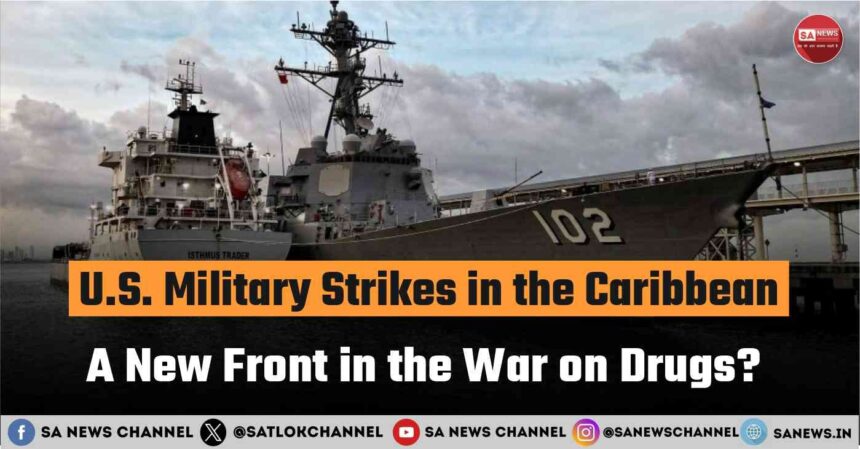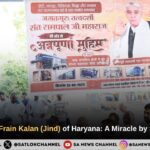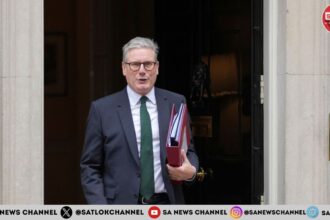U.S. Military Strikes in the Caribbean: On September 2, 2025, a United States military asset conducted a strike in the Caribbean Sea, destroying a speedboat and killing 11 individuals. In a subsequent announcement, President Donald Trump identified the action as a strike against “positively identified Tren de Aragua narco-terrorists” whose vessel was allegedly “loaded with fentanyl.” The event marked the beginning of a significant escalation in U.S. counter-narcotics strategy.
Over the next several weeks, at least six additional vessels were destroyed by military force, resulting in the deaths of their crews without attempts at interdiction or arrest. The White House stated these actions were a necessary measure to protect American lives from the flow of illicit narcotics. However, the strikes prompted condemnation from international legal experts, human rights organizations, and regional governments, who characterized them as “unlawful extrajudicial executions.” This series of events has sparked a global debate: do these actions represent a necessary new strategy in the war on drugs, or a departure from established international legal norms?
A Shift in Counter-Narcotics Strategy
Between September and October 2025, U.S. forces reportedly used helicopters and drones to target and destroy small vessels, such as speedboats and semi-submersibles, leading to the deaths of approximately 30 to 35 individuals described by U.S. officials as suspected traffickers. This approach marked a departure from traditional U.S. counter-narcotics policy, which has historically relied on law enforcement agencies for interdiction, seizure, and arrest.
The administration’s legal rationale for these actions was centered on classifying the targets as “narco-terrorists” and “unlawful combatants.” In an October 2 memo to Congress, the White House asserted that the U.S. was engaged in a “non-international armed conflict” with drug cartels. This reclassification aimed to frame drug trafficking as an act of war, thereby justifying a military response and broad executive authority.
Following each strike, a presidential announcement claimed the targeted vessel carried significant quantities of drugs and was linked to a designated terrorist group. The administration released grainy videos of the explosions, but independent analysts and critics noted the absence of visible drug cargo prior to the vessels’ destruction, raising questions about the evidence.
| Date of Strike | Vessel Type / Description | Official U.S. Justification & Alleged Cargo | Reported Casualties | Contradictory Information & Regional Response |
| Sept 2, 2025 | Speedboat | “Loaded with fentanyl,” linked to Tren de Aragua gang. | 11 killed | No drug bales visible in footage. Venezuela called it an “assassination.” |
| Sept 15, 2025 | Speedboat | Transporting illicit drugs from Venezuela. | 3 killed | Independent analysts only confirmed people aboard, not drugs. |
| Sept 19, 2025 | Vessel | Intelligence confirmed drugs on board. | 3 killed | No independent evidence released. |
| Oct 3, 2025 | Small boat | Carried “enough drugs to kill 25 to 50 thousand people.” | 4 killed | Venezuela condemned the strike. |
| Oct 14, 2025 | Semi-submersible | Trafficking narcotics, associated with “illicit narcoterrorist networks.” | 6 killed | Victims identified by Venezuela as Trinidadian civilians and “humble fishermen.” |
| Oct 16, 2025 | Semi-submersible | “Loaded mostly with Fentanyl.” | 2 killed, 2 survivors | Survivors were quickly repatriated, preventing U.S. legal proceedings. |
| Oct 17, 2025 | Vessel | Carried “substantial amounts of narcotics,” linked to Colombia’s ELN guerrillas. | 3 killed | Colombia’s president denied involvement and called it “murder.” |
The administration’s approach created a political climate where its actions were framed as a necessary response to a national emergency, while critics continued to call for due process and verifiable evidence.
The Fentanyl Crisis: Context for a New Policy
The shift in U.S. policy occurred against the backdrop of a severe public health crisis. The nation is in the third wave of the opioid epidemic, which is primarily driven by fentanyl. A synthetic opioid far more potent than heroin or morphine, fentanyl can be lethal in a dose as small as 2 milligrams.
The global supply chain for fentanyl is complex. Precursor chemicals are often sourced from China and shipped to Mexico, where cartels synthesize the drug. It is then smuggled across the U.S.–Mexico border. Drug overdoses have claimed over 100,000 American lives annually in recent years, with synthetic opioids like fentanyl accounting for approximately 70% of these deaths. The economic impact is estimated at nearly $1.5 trillion per year from healthcare costs, criminal justice expenses, and lost productivity. This atmosphere of widespread death and economic strain created public and political pressure for decisive government action.
The International Legal Debate
The administration’s campaign drew strong criticism from legal scholars and human rights advocates, who argued it conflicted with established principles of international law.
First, critics stated the actions contravened the international law of the sea. Standard maritime protocol for suspected criminal activity involves law enforcement interdiction, not immediate military destruction. No warnings, warning shots, or attempts to board the vessels were reported.
Also Read: U.S. Imposes 25% Tariff on Indian Goods: Key Facts
Second, human rights organizations argued the strikes violated the right to life, as protected under the International Covenant on Civil and Political Rights. They contended that lethal force is permissible only when necessary to prevent an imminent threat to life, a standard they argue was not met by drug smuggling. Consequently, organizations like Human Rights Watch labeled the strikes “unlawful extrajudicial killings.”
Third, the administration’s legal claim of a “non-international armed conflict” with cartels was disputed by many legal scholars. They argued that drug trafficking is a transnational crime, not an “armed attack” that grants a nation the right of self-defense under the UN Charter.
The case of the two survivors from the October 16 strike highlighted this legal tension. After their capture, they were quickly repatriated for prosecution in their home country rather than being held as “unlawful combatants.” Observers interpreted this move as an effort by the administration to avoid a U.S. court case that would have required presenting classified intelligence and defending its “armed conflict” theory.
Geopolitical Context and Alternative Interpretations
Foreign policy analysts questioned whether the stated objective of stopping fentanyl was the sole motivation for the strikes, pointing to several factors. The campaign coincided with a significant U.S. military buildup in the Caribbean, including warships and F-35 fighter jets, a force that many analysts considered disproportionate for intercepting small boats. This led to speculation that the operation was a form of “gunboat diplomacy” aimed at the Venezuelan government of President Nicolás Maduro.
This interpretation was amplified by the fact that the Central Intelligence Agency (CIA), not a law enforcement body, reportedly provided the intelligence for the strikes. The CIA’s involvement ensures that evidence justifying the operations is likely to remain classified. President Trump later confirmed he had authorized broader CIA covert operations within Venezuela, linking the counter-drug effort to a wider pressure campaign.
Experts on drug trafficking also noted that while the primary fentanyl supply chain runs through Mexico, the U.S. military’s focus was on maritime routes from Venezuela, which is considered a minor transit country for drugs headed to the U.S. This discrepancy led critics to suggest that the fentanyl crisis was being used as a public justification for a geopolitical strategy.
The Human Cost of the Policy
Beyond the legal and geopolitical debates, the strikes had a direct human impact. While U.S. officials described the deceased as “narco-terrorists,” reports from the region offered a different perspective. After the October 14 strike, Venezuelan officials identified some of the six deceased men as Trinidadian civilians, and their families described them as “humble fishermen.”
This created a parallel between the victims of the opioid crisis in America and the victims of the military strikes in the Caribbean. The policy intended to address American deaths from fentanyl resulted in grieving families in other nations, highlighting the human toll on both sides of the issue.
A New Precedent
The U.S. military strikes of late 2025 marked a significant shift in counter-narcotics policy. The administration defended the actions as a necessary and decisive response to the domestic fentanyl crisis. In contrast, critics described the strikes as unlawful extrajudicial killings conducted under a disputed legal pretext that conflated criminal activity with acts of war.
The policy raised concerns among international observers about setting a new global precedent, potentially allowing other nations to justify military force against transnational criminal threats. Ultimately, the events in the Caribbean highlighted a fundamental debate over the use of military force for law enforcement, the balance between national security and international law, and whether the primary front in the fight against fentanyl is in foreign waters or within American communities.
A War On False Beliefs, Practices & Social Issues
Just as America’s war on drugs requires drastic measures, so does the war on all evils of the world. And today, Sant Rampal Ji Maharaj is fighting this war, using spiritual ‘weapons of mass instruction’ — the Holy Books. Using the knowledge imparted by Kabir Saheb Ji and Gareeb Das Ji Maharaj, He is clearing millennia-old questions of why evil exists, where humans came from and where we are going.
The problem of Drugs is just an extension to the problem of human suffering, research has shown that the more lonely, depressed and sad a person is, the greater their chance to get addicted. Sant Rampal ji Maharaj, through his books like Gyan Ganga and Jeene Ki Raah (Way Of Living) is showing how these problems can be averted and solved.
The phrase “Finding God” has become a reality—He has proven that God is one. But who? He is Kabir, which Sant Rampal Ji Maharaj has proven through all the Holy Scriptures. And the missiles he is using are his books and satsangs.
The proof of his teachings working are the testimonials of his disciples plastered all over the YouTube Channel : SA True Story.
Catch a glimpse of the reenactment of real life event of a devotee and how Sant Rampalji’s knowledge helped him and millions like him with their addictions:
FAQs:
1) Did the U.S. attack Venezuela?
Ans: The U.S. did not directly attack the nation of Venezuela, but it conducted military strikes in the Caribbean that were interpreted by many as a pressure campaign against the Venezuelan government
2) What did the U.S.A. bomb in the ocean?
Ans: The U.S. bombed small vessels, specifically speedboats and semi-submersibles, that were suspected of trafficking drugs.
3) What is Fentanyl?
Ans: Fentanyl is a powerful synthetic opioid, significantly more potent than heroin or morphine.
4) How deadly is fentanyl?
Ans: Fentanyl is extremely deadly; a dose as small as 2 milligrams can be fatal.
5) Where does fentanyl come from in the U.S.A.?
Ans: The precursor chemicals largely come from China, are synthesized into fentanyl by cartels in Mexico, and then smuggled into the U.S.A.









